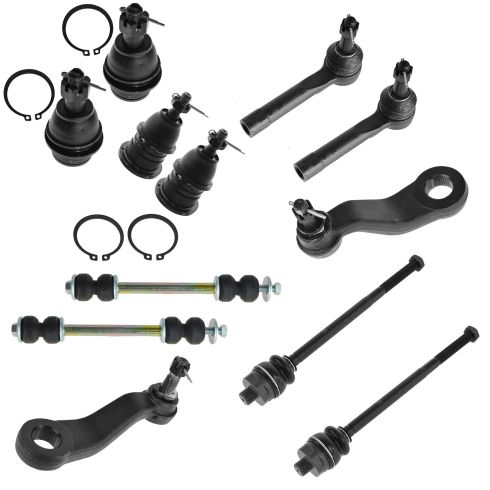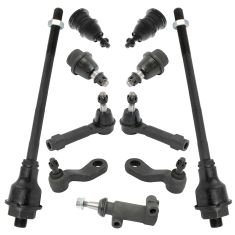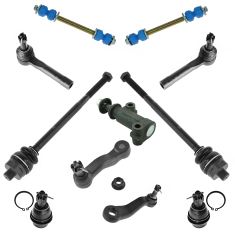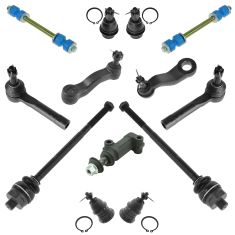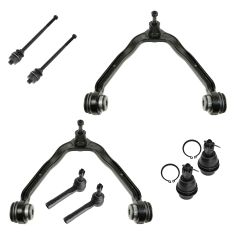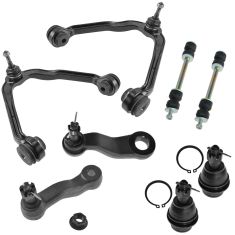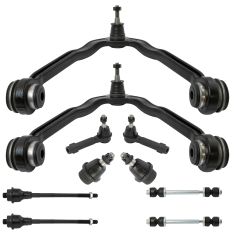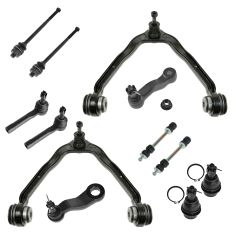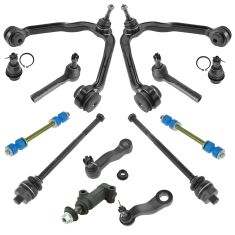Hi, I'm Mike from 1AAuto. We've been selling auto parts for over 30 years! We're dedicated to delivering quality auto parts, expert customer service, and fast and free shipping, all backed by our 100% satisfaction guarantee. We've created thousands of videos to help you install our parts with confidence. That saves you time and money, so visit us at 1AAuto.com, your trusted source for quality auto parts.
All right, to find the idler arm on your truck—it's on the passenger side—is to start at the tie rod end and just follow the arm all the way to your inner tie rod and then up to your idler arm. The idler arm is on the passenger side, and it bolts to the frame of the vehicle and to the steering itself. You can watch the play in it by just moving the tire back and forth forcefully with your hand. There shouldn't be any sort of play in between the idler arm and the steering shaft itself. That is actually the problem here. The vehicle failed inspection because there's too much play here. It's actually to a point where it's actually becoming dangerous, because this is actually going to break apart pretty soon. We want to get in here and replace the idler arm.
The first step to removing the idler is removing the cotter pin that holds the nut in place. I think to use a pair of cutters to grab it with. It's usually the easiest thing to do, although I may prove myself wrong. There we go. Then you can also use a pair of locking pliers to pull it from the other side. Then you'll take your 21-millimeter socket with an extension, and I'm using a 1/2 inch ratchet because it's going to be pretty tight, and we'll crack it loose. Luckily it's greasy, so once you crack it loose it usually spins right off.
Ideally, you want to have a puller, which you can get from your local hardware store or auto parts store. You can usually rent them. You'll want to put it on like this. We're using a two jaw puller. It wraps up on both sides of the steering arm, and then the center bolt pushes right on the idler arm. Then in our case it's a 16-millimeter right here, but depending on the puller it could be a different size. At that point, you want to just tighten up your puller until the idler arm breaks free. We're going to be pulling off the idler arm with the idler arm bracket, so we need to take out the lower nut right here and then the upper one right up here.
In New England, we like to spray everything with rust penetrator because we take it off because it just makes life a lot easier. On the front side of the bracket, there's the actually heads of the bolt that we're going to put a socket on. Right here is the lower one. Then up here is the upper one. We're going to use a 21-millimeter with an extension and a little wobble adapter so that we can get on there. It's not the easiest thing to reach, but once you're on there it should stay there. Then on the backside we'll put a wrench to hold the nut in place, and hopefully turn it.
Now we're heading for the top bolt on the idler arm bracket. We have our 21-millimeter wrench on the backside and then 21-millimeter socket and extension on the front. At this point, we'll be able to just pull the whole idler arm and its bracket right out of the truck like so. With the idler arm off the truck, we put it in a vice, and you can see how much movement there is in it. There obviously shouldn't be any. That should be nice and tight.
We've cleaned up our idler arm and idler arm bracket. Both are well used, but we're going to show you how to separate the idler arm from the bracket itself. In our case, there's a 24-millimeter nut on here. That may differ depending on if your car has an original OEM part or if it's been replaced before. In our case, it's 24-millimeter. We're going to throw it in the vice and put our 24 millimeter socket on with a 1/2 inch ratchet because you want plenty or torque, and hopefully we can crack this loose. With the nut off, now we have to pull the idler arm off the idler arm bracket.
Once again I'm going to reposition this in the vice. Get a puller, which you can rent from a local hardware store or an auto parts store, or they're actually not too expensive if you just buy them and you think you might be doing this more than once. It might be worth buying a kit to do this. Then you'll tighten down the center bolt. In our case, we have a 16-millimeter on the top of the puller, which we will once again use our 1/2 inch ratchet to tighten up. You always want to wear your safety glasses when you're doing these things, safety gloves, because things tend to spring off when you're least expecting it, kind of like that. Now that it's broken loose, you can pull it right off.
Here are the idler arms. You can see the old one right here. This one has a ton of play in this section. I think it's probably due to the fact that somebody didn't grease this on a regular basis. Usually, if you put the grease in and then forget about it for the next 100,000 miles, it's going to wear out the inside, and you're going to need to replace the whole thing again. This one obviously comes with a new greaseable fitting on the top. The key is you just want to make sure that you properly grease these on a regular basis, and it'll pretty much last as long as you take care of it. It also does come with a little foam piece on the bottom like the original has. Yeah, it looks, feels, and acts just like the original.
In our case, we're going to be replacing the idler arm bracket and the idler arm, and this is the same process, whether you're replacing one or the other, but we always recommend doing them both at the same time since you have them both out of the vehicle. It's just a really easy thing and it doesn't cost a whole lot more, or a whole lot more money to swap them both at the same time. To do this, we'll hook the idler arm bracket into the vice and we'll slide the idler arm right onto the bracket. Put the nut on there. This happens to be a 24-millimeter. Depending on what kind of part you have in your car, it may vary. The size may vary a little bit.
At this point, we can tighten this up. We started tightening the nut, and we found that the whole thing was spinning, like you can see here. That's why they put a hex on the top of this, so that you can put a wrench here and a wrench on the bottom, and then you can tighten down the nut much easier. While the idler arm bracket and idler arm are out of the vehicle, we're going to put the grease in them. That way it's a little bit easier on us once they're installed. Now we can slide the whole assembly right back in. There's one bolt in place. Now we'll do the lower bolt, which is a little trickier.
All right, with the top, or with the idler arm bracket bolts in place, then you can push the idler arm into the steering and tighten up the castle nut, or hand tighten the castle nut. Now we're going to take our 21-millimeter socket and extension and place it on the upper bolt and put a wrench on the backside. Of course, we want to turn the ratchet in the proper direction, and we'll start tightening up that bolt. All right, then we'll go for the lower one, which again 21-millimeter with a ratchet and extension and 21-millimeter on the back.
Now we have the 21-millimeter idler arm nut that we are going to use a ratchet and extension and socket on. We want to get it tight enough so that it is held in place, but we also want to line up the castle nut with the hole in the idler arm so that we can get the cotter pin through. Now you can slide the cotter pin through the hole and bend it over so that it stays in place. Now you'll see that when we move the wheels back and forth, the play between the idler arm and the steering bracket no longer exists.
Thanks for watching. Visit us at 1AAuto.com for quality auto parts, fast and free shipping, and the best customer service in the industry.
